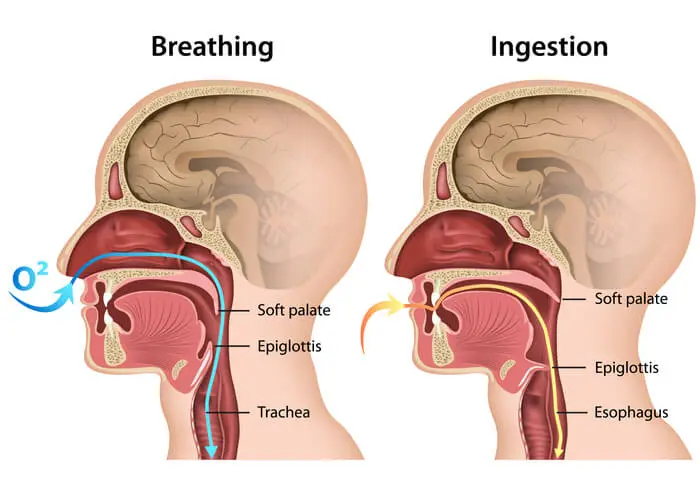Swallowing is a seemingly simple yet remarkably intricate physiological process that often goes unnoticed in our daily lives. From the moment food or liquid enters our mouths to its journey through the esophagus into the stomach, swallowing involves a series of coordinated muscular movements and neural signals. In this comprehensive article, we delve into the anatomy, mechanics, neural control, disorders, and importance of swallowing, shedding light on this essential aspect of human existence.
Table of Contents
ToggleAnatomy of Swallowing
Swallowing involves the coordinated action of various structures within the oral cavity, pharynx, and esophagus. The process can be divided into three main stages:
- Oral Phase
- Pharyngeal Phase
- Esophageal Phase

Oral Phase
The oral phase begins with the placement of food or liquid into the mouth. Here, the tongue manipulates the substance against the hard palate, mixing it with saliva to form a bolus. The bolus is then propelled posteriorly by the tongue to the back of the oral cavity, initiating the swallowing reflex.
Pharyngeal Phase
As the bolus reaches the back of the mouth, sensory receptors in the oropharynx trigger the pharyngeal phase. This reflexive phase involves the elevation of the soft palate to close off the nasopharynx, the closure of the epiglottis to protect the airway, and the contraction of pharyngeal muscles to propel the bolus into the esophagus while simultaneously relaxing the upper esophageal sphincter.
Esophageal Phase
The bolus enters the esophagus and is propelled downward by peristaltic contractions of esophageal muscles. These contractions occur in a coordinated fashion, pushing the bolus towards the stomach while preventing reflux of gastric contents into the esophagus.
Importance of Swallowing
Swallowing is essential for the intake of nutrients and hydration, facilitating the digestion and absorption of food in the gastrointestinal tract. Beyond its physiological importance, swallowing holds significant social and psychological significance, as it plays a central role in communication, socialization, and cultural practices surrounding food and drink.
Moreover, swallowing disorders can have profound consequences, leading to malnutrition, dehydration, aspiration pneumonia, and diminished quality of life. Early recognition and management of swallowing disorders are crucial for optimizing patient outcomes and preventing complications.
Mechanics of Swallowing
Swallowing is facilitated by the intricate coordination of muscles and nerves, both voluntary and involuntary. The muscles involved in swallowing include those of the tongue, pharynx, larynx, and esophagus. Voluntary control over swallowing is mediated by the cerebral cortex, particularly the motor areas responsible for initiating and coordinating muscular movements.
However, once the swallowing reflex is triggered, the process becomes largely involuntary, orchestrated by the brainstem and cranial nerves. The glossopharyngeal nerve (CN IX), vagus nerve (CN X), and hypoglossal nerve (CN XII) play pivotal roles in conveying sensory information from the pharynx, coordinating muscular contractions, and controlling the movements of the tongue and larynx during swallowing.
Neural Control of Swallowing
The neural control of swallowing is a complex interplay between sensory feedback, central pattern generators, and higher brain centers. Sensory receptors in the oral cavity, pharynx, and esophagus provide feedback regarding the volume, consistency, and presence of foreign objects in the ingested material.
Central pattern generators located in the brainstem generate the rhythmic motor patterns necessary for swallowing, while higher brain centers, including the cerebral cortex and limbic system, modulate swallowing behavior based on factors such as taste, temperature, and emotional state.
Disorders of Swallowing
Swallowing disorders, also known as dysphagia, can arise from various causes and affect individuals of all ages. Dysphagia can be categorized as oropharyngeal dysphagia, which involves difficulties in the oral and pharyngeal phases of swallowing, and esophageal dysphagia, which pertains to abnormalities in the esophageal phase.
Common causes of dysphagia include neurological conditions such as stroke, Parkinson’s disease, and multiple sclerosis, which disrupt the neural control of swallowing. Structural abnormalities such as tumors, strictures, and muscular disorders can also impede the passage of food through the digestive tract.
Conclusion
In conclusion, swallowing is a multifaceted process that encompasses anatomical, mechanical, neural, and clinical aspects. Understanding the intricacies of swallowing is essential for healthcare professionals involved in the assessment and management of swallowing disorders. By recognizing the importance of swallowing and its impact on overall health and well-being, we can strive to ensure optimal swallowing function for individuals across the lifespan.

